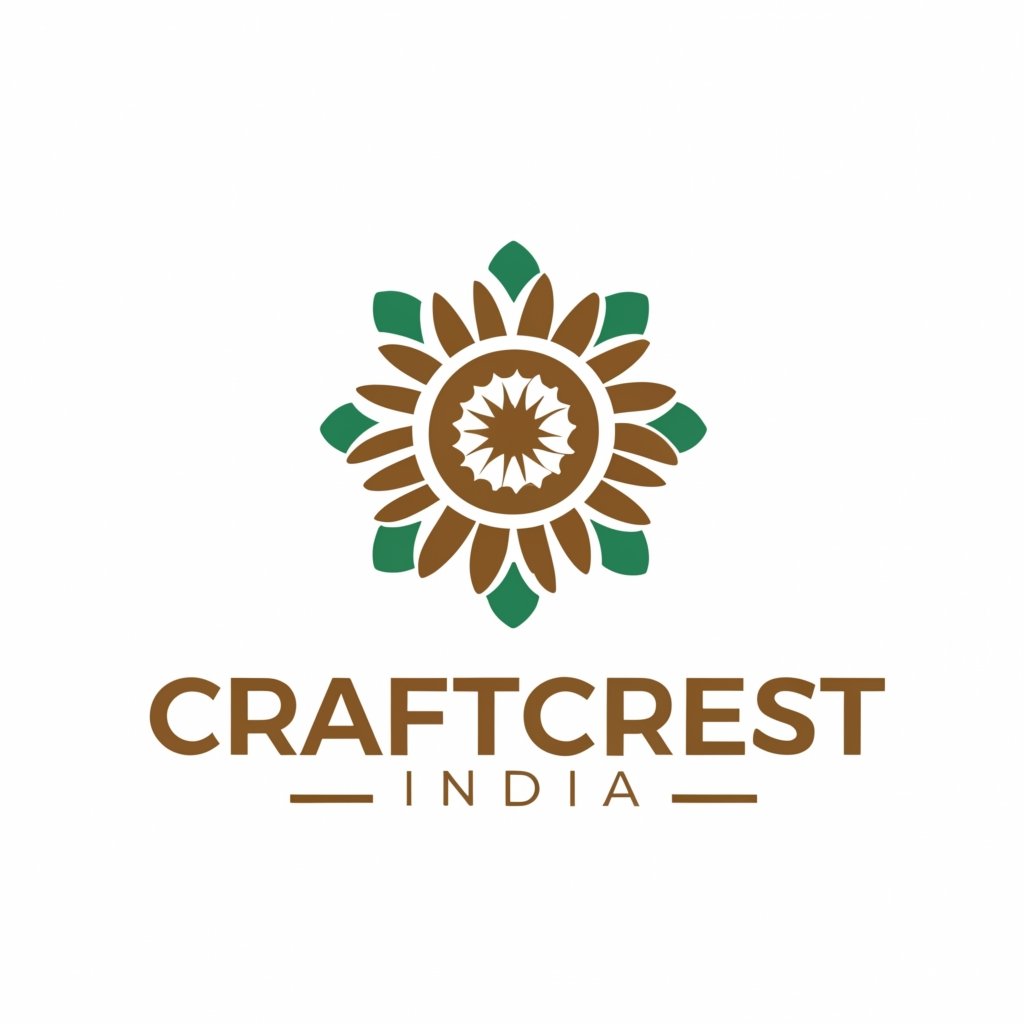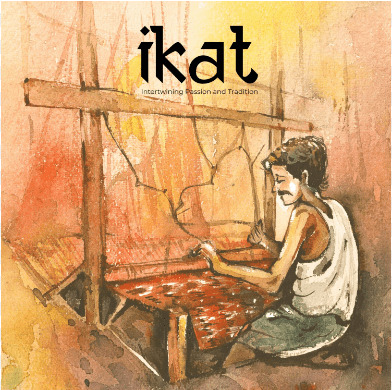
IKAT-AN INTRODUCTION TO THE ANCIENT ART
Ikat handloom art, with its mesmerizing patterns and vibrant hues, is a testament to the rich textile heritage of not just India but also the world over. It is also referred to as “Ikkat” or “Ikhat”. In this comprehensive exploration, we delve deeper into the origins, diverse types, intricate techniques, and profound cultural significance of Ikat, particularly in the Indian context.
HISTORY & ORIGIN OF IKAT
- Etymology: The term “Ikatcomes from the Malay-Indonesian word “Mengikat,” which means “to tie or bind.”. This refers to the resist-dyeing technique used in Ikat, where sections of yarn are tied or bound before dyeing to create patterns.
- Geographical Roots & Spread: Ikat weaving finds its origin in ancient civilizations across Asia, including India, Indonesia, Japan, and Central Asia. These cultures developed unique variations of the art form, each with their own techniques and motifs. With various invaders and traders, the art travelled far and wide, even to Western countries like Argentina, Bolivia, Mexico, and Guatemala. In India, they can be traced back to as far back as the 7th century in the frescos of Ajanta and Ellora caves, where figures adorned garments with Ikat patterns. This was largely attributed to the trade ties of India with China and Indonesia.
- Cultural Significance:Ikat textiles have held a significant place in the cultural and social fabric of society for centuries. They were not merely garments but symbols of status, worn during ceremonies, rituals, and important occasions.
IKAT-DIFFERENT WEAVING TECHNIQUES
Warp Ikat
Weft Ikat
Double Ikat
- Single Ikat: In single Ikat, either the warp or weft threads are resist-dyed before weaving, resulting in patterns on one side of the fabric. Depending on which threads are resist dyed, these are called “warp” or “weft” ikats. This technique is commonly used in Rajkot patola.
- Double Ikat: Double Ikat involves resist-dyeing both the warp and weft threads before weaving, creating intricate designs on both sides of the fabric. A great illustration of double Ikat weaving is Patan Patola.
- Combined Ikat: When Warp & Weft Ikats co-exist in the same fabric at different places and overlap at times too,.
MAKING OF IKAT FABRIC – THE STEPS INVOLVED
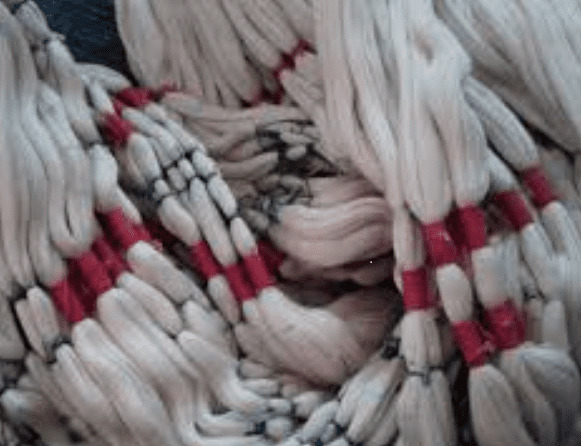

While knowing the Ikat weave production process might be a complete chapter in itself, we’ll only skim through it here to get a basic knowledge of the three phases below.
- Resist Dyeing: The heart of Ikat weaving lies in the resist-dyeing technique, where sections of yarn are tightly bound with threads to prevent dye penetration. This meticulous process requires precision and skill to achieve intricate patterns.
- Loom Preparation: Before weaving, artisans meticulously arrange the dyed warp and weft threads on the loom, ensuring the alignment of colors and patterns. This step is crucial for achieving the desired design and symmetry in the final product.
- Weaving: Skilled weavers use traditional handlooms to interlace the dyed threads, carefully following the predetermined pattern. The weaving process requires patience, dexterity, and attention to detail to create flawless Ikat textiles.
POPULAR IKAT CRAFTSMANSHIP FROM VARIOUS REGIONS OF INDIA
Let us have a look at some of India’s most popular and cherished Ikat art pieces, which are practiced in various places. While each one of them might be a full topic in itself to talk about, we will try to comprehend them simply below. The majority of them have received GI tags (geographic indication) due to their distinctive designs and craftsmanship connected with their regions of origin. This protects the art’s history and helps to keep it in its original form for future generations.
1. ODISHA’S SAMBALPURI IKAT
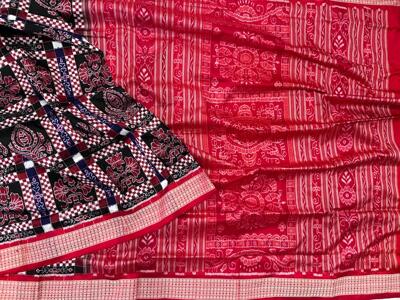
Originating from the western Odisha region, the Sambalpuri sarees and fabrics are prized for their exquisite craftsmanship and cultural significance. In the local community, they are still called “Bandha Kala, which means “to tie” in Odiya. The colours used are usually red, black, and white, which symbolize the colors of Lord Jagannath. They are woven using cotton as well as mulberry silk yarns. The motifs used are very intricate, precise, and detailed. They are inspired by nature and the religious and cultural beliefs of the region. These exquisite art pieces feature traditional motifs such as flowers, peacocks, ducks, fish, and conch shells, apart from Konark wheel and Kumbha or temple motifs. They have been largely produced by the tribal “Bhuliya” community, who have been practicing this art for ages and have also evolved it with time, still retaining its authenticity.
Orissa boasts several varieties of Ikat sarees named after their places of origin, and each of them has a unique design feature associated with it. To name a few, we can talk about Sonepuri, Pasapali (chess board motifs), Bomkai, Barpali, and Bapta saris (silk-cotton base with gold thread). These sarees garnered a lot of attention when the late Prime Minister, Mrs. Indira Gandhi, embraced them on different occasions.
2. GUJARAT’S PATAN PATOLA

It is the most prized possession of the state and is a double Ikat textile from the Patan region of Gujarat, renowned for its intricate designs and precision weaving using delicate silk yarns. Each Patola saree is an artistic marvel that takes months to a year to complete. They are the sharpest and most vibrant of the Ikats produced in India. Patola patterns are distinctly geometric and like pixels. Designs are inspired by nature (leaf, flower, animals like elephants, tigers, birds like parrots, etc.) and local architecture (like patterns in the Rani ki Vav stepwells of Patan). Each motif, or “Bhat,” has its own significance for different communities that patronised this art (Jains, Vohra, and Ismaeli Shia Muslims).
These are very expensive due to the sheer intricacy and labour involved in the art, and at one point in time, these patolas were worn only by royalty. Research from the Times of India on the subject indicates that the art has been a closely guarded secret passed on from one generation to the next (only sons) through the ages. This art was introduced during the reign of King Kumarpal of Solanki dynasty It is said that in today’s times, there are merely three families in Patan who have kept this art alive.
There is another Patola (Rajkot Patola), which is famous in the Rajkot region of the state. This one uses the single-ikat weaving technique and, hence, is relatively less complex, takes less time to produce, and is relatively less expensive too.
3. TELANGANA’S (ERSTWHILE ANDHRA’S) POCHAMPALLY IKAT
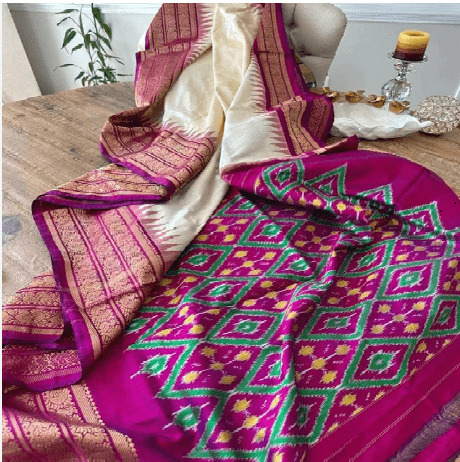
Also known as Pochampally silk or Bhoodan Pochampally (because of its association with the “Bhoodan movement” of Vinoba Bhave) or “Paagadu Bandhu” in Telegu, this art is a hallmark of Telangana’s textile heritage. The intricate geometric patterns and vibrant colours of Pochampally sarees have earned them global recognition. Like Patan Patola these use the double Ikat technique in weaving and are characterised by their unique motifs and vivid colors. The patterns and motifs are relatively simpler though being mostly geometrical and some nature inspired too. Other patterns include chevron or striped shapes. The fabric base is mostly silk (these are the brightest and most resplendent) and also silk cotton and cotton (mostly white based).
In a radius of 70 km around Hyderabad, at least 40 villages produce Pochampally ikat textiles, according to the geographical indication (GI) tag application. This covers Pochampally, Koyalagudam, Puttapakka, Elanki, Chautupal, and portions of Nalgonda and Warangal.
Another popular version is the double Ikat Telia Rumal from this region which is also covered under the same GI tag as Pochampally. It is characterised by distinct sharp patterns and a shine that comes from use of castor ash and sesame oil which also imparts it a cooling effect. These were generally seen in red, black and white geometric patterns offset by a single-coloured borders. Telia Rumals were largely used by the fishermen and cowherd communities and became very popular as an export item(headscarves) to Myanmar (Burma), Middle east and East Africa. The once dying art is now on path of revival.
IKAT-MODERN DAY RELEVANCE
- Cultural Identity: Ikat textiles are deeply intertwined with the cultural identity and heritage of communities across India. They serve as symbols of tradition, history, and social status, reflecting the rich tapestry of Indian culture.
- Economic Empowerment: The handloom industry, including Ikat weaving, employs millions of craftsmen, primarily women, in rural areas. Supporting Ikat artists helps to promote rural development, economic empowerment, and the preservation of traditional crafts.
- Global Recognition: Ikat textiles have gained widespread acclaim on the global stage for their exquisite craftsmanship, intricate designs, and cultural significance. They are sought after by connoisseurs and fashion enthusiasts worldwide, bolstering India’s cultural exports and heritage. The GI tags attributed to many of these art pieces are a testament to their global recognition too.
CONCLUSION
Ikat handloom art represents India’s rich textile tradition, artistic inventiveness, and cultural variety. Ikat’s ageless beauty and fine craftsmanship have inspired awe from its ancient roots to its present renaissance. Its usage can be found in an array of products, including sarees and fabrics, ready-to-wear clothing (shawls, scarves, headscarves, kurtas, kurtis, dresses, and so on), as well as home furnishings (bedsheets). Cushion covers, carpets, etc.) and accessories (bags, belts, and even contemporary jewellery).
By honouring Ikat’s legacy and supporting its artists, we celebrate not just a craft but a living tradition that ties us to our past and shapes our future.Explore this wonderful tradition with Craftcrest India.

